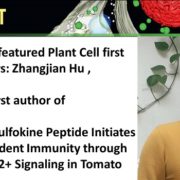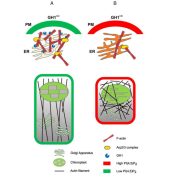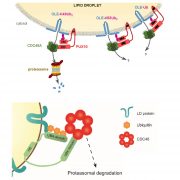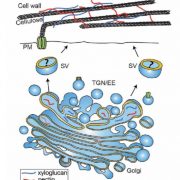Protoplast Swelling Requires AUXIN BINDING PROTEIN1
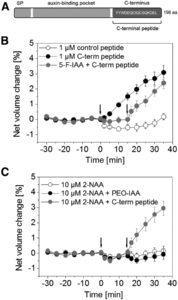 Convincing molecular and biochemical evidence exists that members of the TRANSPORT INHIBITOR RESPONSE1/AUXIN SIGNALING F-BOX PROTEIN (TIR1/AFB) receptor family are auxin receptors that trigger auxin-induced gene expression and hypocotyl growth through enhanced expression of SMALL AUXIN UP RNA genes. These TIR1/AFB members, however, were not the first proteins suggested to be auxin receptors. Earlier research focused on another protein, AUXIN BINDING PROTEIN1 (ABP1), as an auxin receptor. ABP1’s function, however, has always been a matter of controversy. Rapid auxin-induced electrophysiological responses as well as auxin-induced protoplast swelling have been shown to be mediated by ABP1; thus, ABP1 was proposed as a receptor candidate for a nontranscriptional pathway for rapid auxin-induced effects. Dahlke et al. (10.1104/pp.17.00733) have now employed a pharmacological approach using α-(phenylethyl-2-oxo)-indole-3-acetic acid (PEO-IAA) and 5-fluoroindole-3-acetic acid (5-F-IAA) to discriminate between ABP1 and TIR1/AFB-mediated processes. They measured both volume changes in single Arabidopsis hypocotyl protoplasts and hypocotyl growth. 5-F-IAA selectively activated the TIR1/AFB pathway but did not induce protoplast swelling; instead, it showed auxin activity in the hypocotyl growth test. In contrast, PEO-IAA induced an auxin-like swelling response, but no hypocotyl growth. Thus, ABP1 seems to be involved in mediating rapid auxin-induced protoplast swelling, but it is not involved in the control of rapid auxin-induced growth.
Convincing molecular and biochemical evidence exists that members of the TRANSPORT INHIBITOR RESPONSE1/AUXIN SIGNALING F-BOX PROTEIN (TIR1/AFB) receptor family are auxin receptors that trigger auxin-induced gene expression and hypocotyl growth through enhanced expression of SMALL AUXIN UP RNA genes. These TIR1/AFB members, however, were not the first proteins suggested to be auxin receptors. Earlier research focused on another protein, AUXIN BINDING PROTEIN1 (ABP1), as an auxin receptor. ABP1’s function, however, has always been a matter of controversy. Rapid auxin-induced electrophysiological responses as well as auxin-induced protoplast swelling have been shown to be mediated by ABP1; thus, ABP1 was proposed as a receptor candidate for a nontranscriptional pathway for rapid auxin-induced effects. Dahlke et al. (10.1104/pp.17.00733) have now employed a pharmacological approach using α-(phenylethyl-2-oxo)-indole-3-acetic acid (PEO-IAA) and 5-fluoroindole-3-acetic acid (5-F-IAA) to discriminate between ABP1 and TIR1/AFB-mediated processes. They measured both volume changes in single Arabidopsis hypocotyl protoplasts and hypocotyl growth. 5-F-IAA selectively activated the TIR1/AFB pathway but did not induce protoplast swelling; instead, it showed auxin activity in the hypocotyl growth test. In contrast, PEO-IAA induced an auxin-like swelling response, but no hypocotyl growth. Thus, ABP1 seems to be involved in mediating rapid auxin-induced protoplast swelling, but it is not involved in the control of rapid auxin-induced growth.




